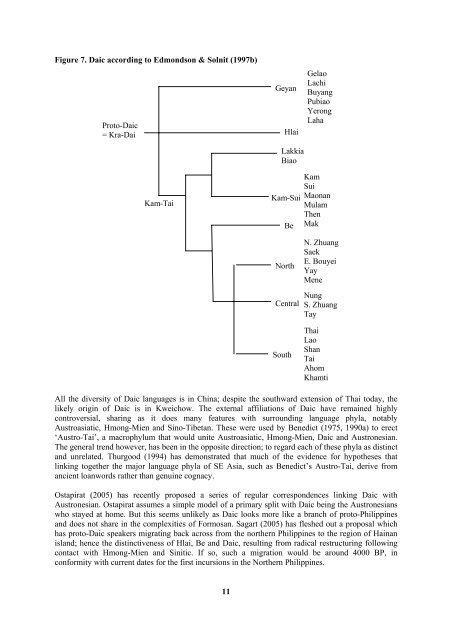Geneva paper 2004 submit.pdf - Roger Blench
Geneva paper 2004 submit.pdf - Roger Blench
Geneva paper 2004 submit.pdf - Roger Blench
Create successful ePaper yourself
Turn your PDF publications into a flip-book with our unique Google optimized e-Paper software.
Figure 7. Daic according to Edmondson & Solnit (1997b)<br />
Proto-Daic<br />
= Kra-Dai<br />
Geyan<br />
Hlai<br />
Lakkia<br />
Biao<br />
Gelao<br />
Lachi<br />
Buyang<br />
Pubiao<br />
Yerong<br />
Laha<br />
Kam-Tai<br />
Kam-Sui<br />
Be<br />
Kam<br />
Sui<br />
Maonan<br />
Mulam<br />
Then<br />
Mak<br />
North<br />
Central<br />
k<br />
South<br />
N. Zhuang<br />
Saek<br />
E. Bouyei<br />
Yay<br />
Mene<br />
Nung<br />
S. Zhuang<br />
Tay<br />
Thai<br />
Lao<br />
Shan<br />
Tai<br />
Ahom<br />
Khamti<br />
All the diversity of Daic languages is in China; despite the southward extension of Thai today, the<br />
likely origin of Daic is in Kweichow. The external affiliations of Daic have remained highly<br />
controversial, sharing as it does many features with surrounding language phyla, notably<br />
Austroasiatic, Hmong-Mien and Sino-Tibetan. These were used by Benedict (1975, 1990a) to erect<br />
‘Austro-Tai’, a macrophylum that would unite Austroasiatic, Hmong-Mien, Daic and Austronesian.<br />
The general trend however, has been in the opposite direction; to regard each of these phyla as distinct<br />
and unrelated. Thurgood (1994) has demonstrated that much of the evidence for hypotheses that<br />
linking together the major language phyla of SE Asia, such as Benedict’s Austro-Tai, derive from<br />
ancient loanwords rather than genuine cognacy.<br />
Ostapirat (2005) has recently proposed a series of regular correspondences linking Daic with<br />
Austronesian. Ostapirat assumes a simple model of a primary split with Daic being the Austronesians<br />
who stayed at home. But this seems unlikely as Daic looks more like a branch of proto-Philippines<br />
and does not share in the complexities of Formosan. Sagart (2005) has fleshed out a proposal which<br />
has proto-Daic speakers migrating back across from the northern Philippines to the region of Hainan<br />
island; hence the distinctiveness of Hlai, Be and Daic, resulting from radical restructuring following<br />
contact with Hmong-Mien and Sinitic. If so, such a migration would be around 4000 BP, in<br />
conformity with current dates for the first incursions in the Northern Philippines.<br />
11
















